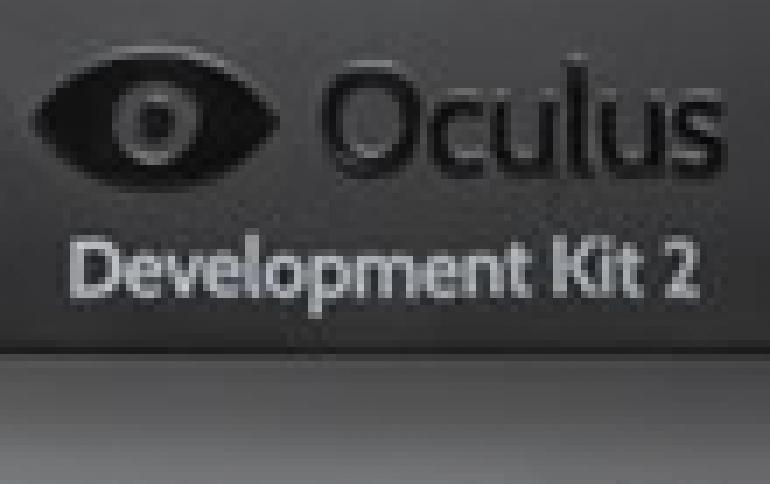
Oculus A Little Closer to Launch With New Oculus Rift Development Kit 2
Oculus VR, a startup trying to popularize virtual reality with its Oculus Rift goggles, said Wednesday it will begin accepting orders for a new development kit.
Almost exactly one year after shipping the original dev kit, the company's second development kit (DK2) for the Oculus Rift DK2 is a reality. It features many of the core elements of the consumer Rift including a low-persistence, high-definition display and low-latency positional head tracking.
DK2 isn't identical to the consumer Rift, but is packs the fundamental building blocks for VR and all the content developed using DK2 will work with the consumer Rift.
Like the Crystal Cove prototype, DK2 uses a low persistence OLED display to eliminate motion blur and judder, two of the biggest contributors to simulator sickness. Low persistence also makes the scene appear more visually stable, increasing the potential for presence. The high-definition 960?1080 per-eye display reduces the screen-door effect and improves clarity, color, and contrast.

DK2 also integrates precise, low-latency positional head tracking using an external camera that allows you to move with 6-degrees-of-freedom and opens up all sorts of new gameplay opportunities like peering around corners.
The Oculus VR team has also included updated orientation tracking, a built-in latency tester, an on-headset USB accessory port, new optics, elimination of the infamous control box, a redesigned SDK and further optimized Unity and Unreal Engine 4 integrations.
DK2 will be $350 at launch and you can pre-order the hardware starting today at www.oculusvr.com/order. Oculus VR expects to begin shipping the first batch of DK2s in July.
The company is debuting the second development kit this week at the Game Developers Conference in San Francisco with EVE: Valkyrie by CCP, UE4 Elemental Defense by Epic, and a new demo, UE4 Couch Knight.
Couch Knight was built by the team at Epic Games to showcase the positional tracking and basic avatars in a setting with shared presence. The tech demo juxtaposes a realistic scene with two cartoon knights, controlled by the players, who burst to life and battle throughout the room on couches, shelves and even the players? avatars.
The players? head movements and position are actually mapped to the avatars using UE4?s inverse kinematic system, which makes for a taste of a social experience.
Oculus VR says it has a lot more planned, including improvements to comfort, resolution, tracking, software, ergonomics, optics, and the industrial design.
DK2 isn't identical to the consumer Rift, but is packs the fundamental building blocks for VR and all the content developed using DK2 will work with the consumer Rift.
Like the Crystal Cove prototype, DK2 uses a low persistence OLED display to eliminate motion blur and judder, two of the biggest contributors to simulator sickness. Low persistence also makes the scene appear more visually stable, increasing the potential for presence. The high-definition 960?1080 per-eye display reduces the screen-door effect and improves clarity, color, and contrast.

DK2 also integrates precise, low-latency positional head tracking using an external camera that allows you to move with 6-degrees-of-freedom and opens up all sorts of new gameplay opportunities like peering around corners.
The Oculus VR team has also included updated orientation tracking, a built-in latency tester, an on-headset USB accessory port, new optics, elimination of the infamous control box, a redesigned SDK and further optimized Unity and Unreal Engine 4 integrations.
DK2 will be $350 at launch and you can pre-order the hardware starting today at www.oculusvr.com/order. Oculus VR expects to begin shipping the first batch of DK2s in July.
The company is debuting the second development kit this week at the Game Developers Conference in San Francisco with EVE: Valkyrie by CCP, UE4 Elemental Defense by Epic, and a new demo, UE4 Couch Knight.
Couch Knight was built by the team at Epic Games to showcase the positional tracking and basic avatars in a setting with shared presence. The tech demo juxtaposes a realistic scene with two cartoon knights, controlled by the players, who burst to life and battle throughout the room on couches, shelves and even the players? avatars.
The players? head movements and position are actually mapped to the avatars using UE4?s inverse kinematic system, which makes for a taste of a social experience.
Oculus VR says it has a lot more planned, including improvements to comfort, resolution, tracking, software, ergonomics, optics, and the industrial design.





















